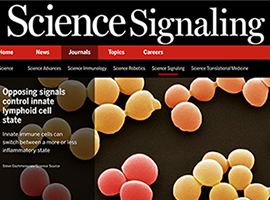Eric Vivier and Charlotte Viant, in association with an international group of scientists, showed that opposing signals in the tissue microenvironment balance the number of inflammatory innate lymphoid cells.
 Like the T cells and B cells of the adaptive immune system, cells in the innate immune system are key to organismal health. Innate lymphoid cells (ILCs) are a heterogeneous type of innate immune cell that regulates immune responses and tolerance at mucosal surfaces, such as in the gut, by rapidly secreting cytokines.
Like the T cells and B cells of the adaptive immune system, cells in the innate immune system are key to organismal health. Innate lymphoid cells (ILCs) are a heterogeneous type of innate immune cell that regulates immune responses and tolerance at mucosal surfaces, such as in the gut, by rapidly secreting cytokines.
Group 3 ILCs (ILC3s) are characterized by the presence or absence of a cell surface natural cytotoxicity receptor (NCR). Two studies now provide evidence of heterogeneity and plasticity within ILC3s. Chea et al. found that a substantial proportion of mouse NCR− ILC3s differentiated into NCR+ILC3s in response to stimulation of the receptor Notch2. In mice with defective Notch signaling specifically in lymphoid cells, NCR+ ILC3s were reduced in number and showed impaired cytokine secretion. Viant et al. showed that Notch signaling was required for the maintenance of NCR+ ILC3s. Furthermore, signaling by the cytokine transforming growth factor–β (TGF-β) antagonized Notch signaling, resulting in reduced numbers of NCR+ ILC3s.
Together, these studies indicate that ILC3 subset composition in vivo depends on the balance between different signals found in tissue microenvironments, which has implications for whether immune responses or tolerance will prevail.
Listen to aaas posdcat from May 3, 2016.
Authors: Charlotte Viant, Lucille C. Rankin, Mathilde J. H. Girard-Madoux, Cyril Seillet, Wei Shi, Mark J. Smyth, Laurent Bartholin, Thierry Walzer, Nicholas D. Huntington, Eric Vivier, Gabrielle T. Belz.